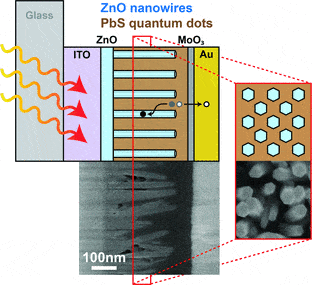For some years now, scientists have been exploring the use of quantum dots as the basis for a novel type of solar cell. The advantages over conventional solar photovoltaic cells are numerous, minus one aspect: efficiency, which is actually the most important one. A new technique developed at MIT labs that uses quantum dots in conjunction with nanowires has lead to a significant increase in efficiency, lending hope that sometime they might become viable enough to enter mass production and become a sound alternative to current solar energy capturing technology.
A quantum dot is a particle of matter so small that the addition or removal of an electron changes its properties in some useful way. All atom are, of course, quantum dots, but multi-molecular combinations can have this characteristic as well. For some time, quantum dots have been the subject of research in the field of solar energy as scientists have been interested in using them as the absorbing photovoltaic material, instead of bulk materials like the most commonly used one, silicon.
What makes quantum dots extremely appealing is their wide range energy bandgaps which allows them to absorb light over a much wider range of wavelengths than conventional devices. Moreover, if proven efficient quantum dots-based solar cells would be at a significant logistical and economic advantage over conventional solutions since they can be manufactured at room temperature, saving a lot of energy (translating in less money spent and less harm done to the environment) that would normally be traded off for the high temperature processing of silicon and other PV materials. Also, quantum dots can be made out of just about any kind of material that do not require extensive purification, as silicon does. Quantum dot PV cells can also be applied on virtually any kind of surface, be them flexible like clothing or rigid like roof tops. A while ago we mentioned a nifty quantum dot paint that could be used to turn any kind of surface into a solar cell that works.
A new generation of solar cells?

If quantum dot PV cells are so awesome, why aren’t we hearing more about them? Why aren’t they everywhere? The short answer is because they’re really, really poor at transferring energy. Efficiency range somewhere in the range of 2-3%, at best.
This is due to a sort of paradoxical structure solar cells need to have in order to be efficient, namely: the absorbing layer needs to be thin enough to allow charged particles absorbed from solar energy to pass directly through wires that carry the current away, but it needs to be thick enough to absorb light efficiently. So you get better in one place, only to find you’ve worsen the other. It’s because of this discrepancy that researchers usually turn to tradeoffs in designing their devices.
Joel Jean, a doctoral student in MIT’s Department of Electrical Engineering and Computer Science (EECS), is the lead author of recently published paper in the journal Advanced Materials where a novel technique is used to boast quantum dots PV cells efficiency by employing nanowires – extremely thin wires with a fantastic length to width ratio which conduct electricity through wires that are 2000 times thinner than a strand of hair.
These nanowires are conductive enough to extract charges easily, but long enough to provide the depth needed for light absorption, Jean says. Using a bottom-up growth process to grow these nanowires and infiltrating them with lead-sulfide quantum dots produces a 50 percent boost in the current generated by the solar cell, and a 35 percent increase in overall efficiency, Jean says.
“If you shine light along the length of the nanowires, you get the advantage of depth,” he says. But also, “you decouple light absorption and charge carrier extraction, since the electrons can hop sideways onto a nearby nanowire and be collected.”
Tests of the device have rendered efficiency in the order of 5 percent, among the greatest ever recorded for quantum dots PVs. The researchers hope that with a little more effort and tuning they could increase this to 10 percent, which is currently the minimal efficiency threshold with which commercial solar cells are produced today. Further research will, among other things, explore using longer nanowires to make thicker films, and also work on better controlling the spacing of the nanowires to improve the infiltration of quantum dots between them.
Expect to hear more and more from quantum dots PV cells, though. Much more…
Was this helpful?



